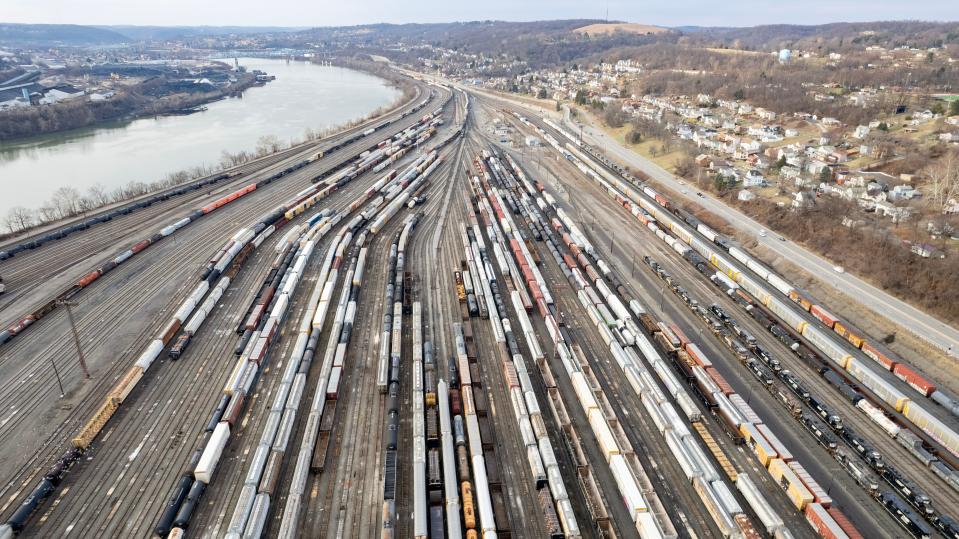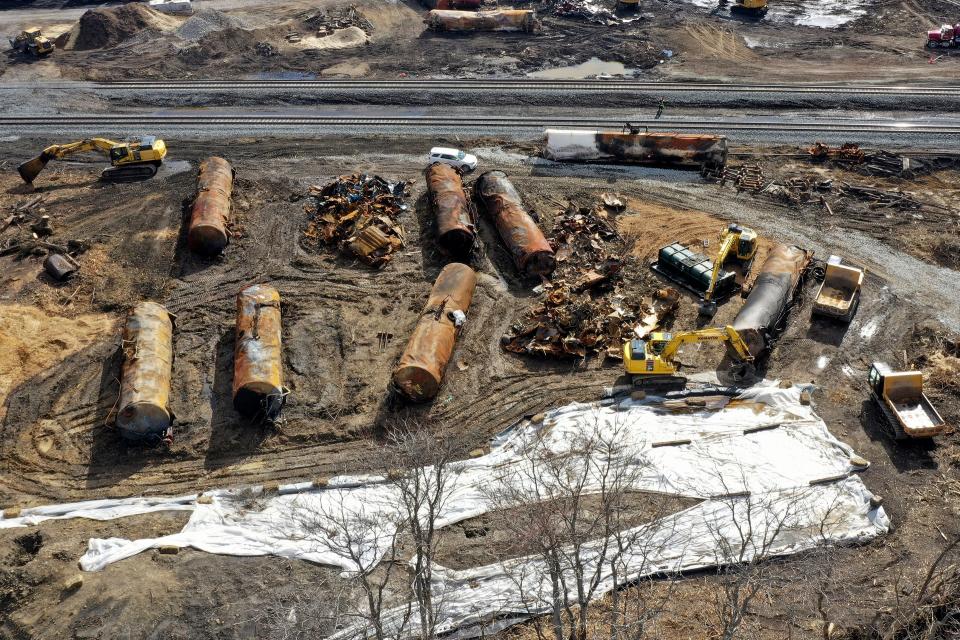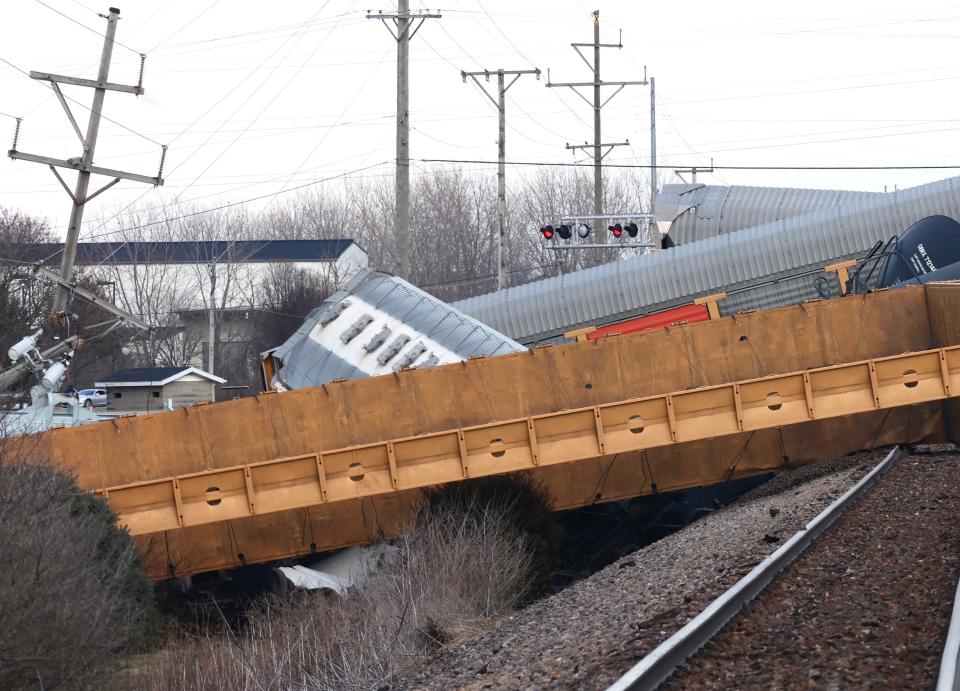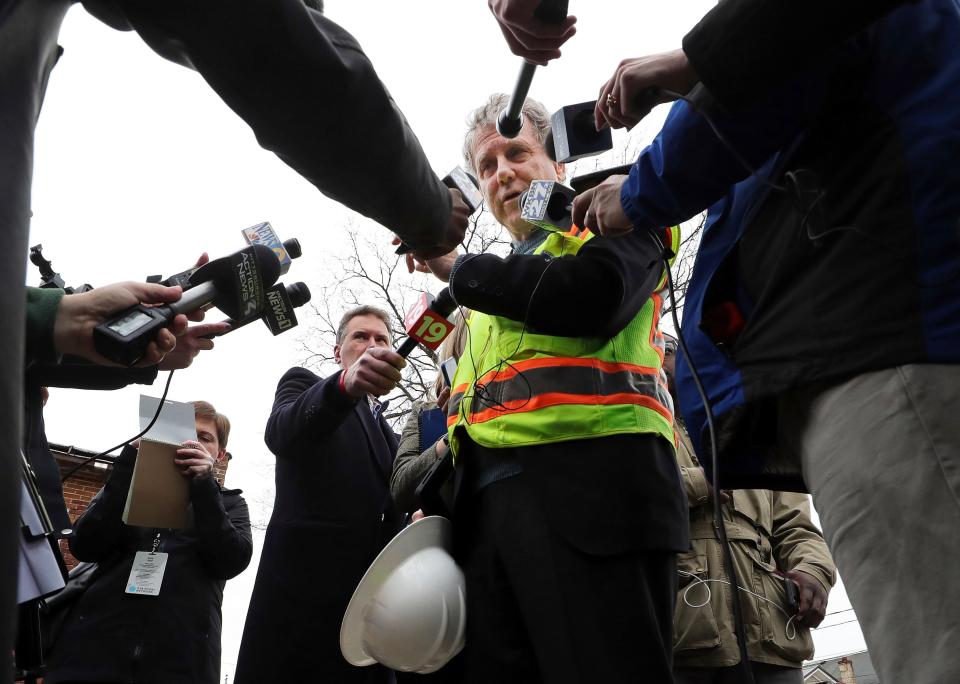What we know and don't know about the hazards on PA's rails
The Feb. 3 Norfolk Southern train derailment that leaked vinyl chloride, a known carcinogen, into the water, soil and air just a mile from the Pennsylvania border has raised myriad questions about the hazardous materials traveling by rail into, out of and through the state every day and whether emergency responders and the public are prepared if a similar disaster happens here.
And with good reason: Pennsylvania has more freight railroad operators — 59, which includes three Class 1, three regional and 53 short line railroads — than any other state, and the third most rail miles, 5,228, behind only Texas and Illinois, according to the Association of American Railroads.
More:Norfolk Southern agrees to pay millions to PA for initial impact of train derailment

In 2021, as many as 2 million carloads of freight, or about 100 million tons, originated, terminated or both in Pennsylvania. And that doesn't count the freight just passing through the Keystone State, which the industry doesn't track.
But the answers aren't easy to find because railroad companies don't publicly share the routes or schedules of trains, including those carrying hazardous materials, citing proprietary information and the risk of terrorism. They're only required to notify states about trains carrying large quantities of flammable liquids, but not about chemicals that fall into the eight other classifications of hazardous materials, including the category that vinyl chloride falls under.
Data from the Association of American Railroads, information from one of the major railroads operating in Pennsylvania, as well as public documents from agencies like the Pipeline and Hazardous Materials Safety Administration offer a glimpse at the hazardous materials crisscrossing the thousands of miles of rail running through small towns, cities and swaths of farmland each day.
Here's what we know:
As much as 40% of the freight transported by rail each year in Pennsylvania is considered a hazardous material, according to testimony from Carl Belke, president of the Keystone State Railroad Association, an industry trade group, during a state Senate Transportation Committee hearing on Feb. 27.
More than 54 million tons of flammable liquids, which are Class 3 hazardous materials and include crude oil, gasoline, ethanol, methanol and pesticides with flammable solvents, paints, stains and lacquers, originated in or were destined for Pennsylvania by rail in 2017, according to the state's most recent Commodity Flow Survey and the Bureau of Labor Statistics. That's enough to fill up an Olympic-size swimming pool more than 25,000 times.
In the same period, more than 17 million tons of non-Class 3 hazardous materials were moved by rail.
Over a 10-year period, between 2013 through 2022, there were 212 incidents in which a hazardous material was leaked or spilled, either as a result of an accident, faulty equipment or another reason via trains in Pennsylvania: Crude oil accounted for the most incidents, 41, with liquified petroleum gas next, having been involved in 33 incidents. Overall, petroleum products were involved in nearly 40% of all hazardous material railway incidents over the last decade, according to data from the Pipeline and Hazardous Materials Safety Administration, a division of the U.S. Department of Transportation.
CSX Transportation, the state's second largest freight carrier, reported that in 2022 about 42% of all hazardous materials it transported in Pennsylvania were categorized as Class 3 hazardous materials. Another 23% were Class 2 materials, or gases like liquified petroleum gas or vinyl chloride, while 11% were Class 8 materials, which are corrosives such as mercury or the components in batteries, for example.
Norfolk Southern did not provide similar information, but a fact sheet notes that 11% of its trains inbound to Pennsylvania contain chemicals, while chemicals make up only 3% of its outbound freight. It is unclear, though, what percentage of these chemicals or other freight is hazardous.

What happened in Ohio
At 8:55 p.m. Feb. 3, 51 cars on the 150-car Norfolk Southern train traveling from Madison, Illinois, to the Conway Yard, in Conway, Pennsylvania, derailed less than a mile from the Ohio-Pennsylvania line, causing 11 tank cars to dump more than 100,000 gallons of hazardous materials.
The content of several cars burned for two days before emergency crews conducted a controlled burn to prevent a larger explosion and reduce environmental damage. The controlled burn of the vinyl chloride, which is used to make PVC pipes, led to the release of hydrogen and phosgene into the atmosphere. Residents in a 1-mile radius of the derailment were evacuated. Emergency responders from Pennsylvania, West Virginia and Ohio responded to the derailment.
Since the derailment, lawmakers, industry leaders, affected residents in both states and others have been discussing how to prevent such a derailment from happening again.
Allan Zarembski, an international expert on railroad safety who leads the University of Delaware's Railroad Engineering and Safety Program, expects lawmakers to approve new regulations as a result of the accident.
But Zarembski also said it's important to put the derailment and the industry's track record into context: No one was killed or injured in East Palestine, and the industry itself has a strong track record when it comes to safety. Railroad companies are making significant investments in infrastructure in part because they're profitable and derailments are costly. That's a major change from the 1960s and '70s, when railroads were losing money and opting for "deferred maintenance." Accidents, he noted, have declined over the last six years.
"There's no smoking gun here," he said. "There's no horrible problem here. There's no disaster here. We had a bad accident. Ohio was a bad accident. There's no taking that away from it. But it was on the statistical end of the probability curve."
There's no way to eliminate train derailments short of stopping rail traffic entirely, but that would put all of those hazardous materials on the highway system, which doesn't have the capacity and is considered in worse condition than rail infrastructure, he said, noting that there is only one derailment on the main rail line for every million miles a train travels.
"What we've got to do is keep chipping away at safety and just incrementally improve," said Zarembski, who in 2015 was asked by then-Pennsylvania Gov. Tom Wolf to prepare a report on crude train safety. "And I think that's what's going to happen."
Oil and gas exploration
The last time the federal government made significant changes to railroad regulations involving hazardous materials was almost a decade ago.
An uptick in domestic oil production starting in 2000, spurred by new drilling technologies and regulations, resulted in millions of barrels of crude oil and liquified natural gas being transported by rail to refineries and other facilities by rail.
With this boom in energy production, which included vast supplies of crude oil from the Bakken shale formation in North Dakota, came an increase in train accidents. Since 2013, there have been more than 20 derailments in North America involving crude oil alone, including the 2013 derailment that killed 47 people and destroyed 37 buildings in the town of Lac-Mégantic, Quebec, Canada, and a 2015 derailment outside of Mount Carbon, West Virginia, that spilled 378,000 gallons of oil and caught fire, leading to several fireball eruptions.
At the same time, as many as 70 to 80 trains were carrying Bakken crude oil from North Dakota into Pennsylvania each week, according to reports.
An influx of oil train accidents prompted federal and state lawmakers to re-examine rail regulations and standards for tanker cars at the time. Among the new regulations was a requirement that railroads notify states before so-called "high-hazard flammable trains" travel through the state.
High-hazard flammable trains are defined as any train with either a continuous block of 20 or more tanks cars or 35 total tank cars, containing a Class 3 (flammable liquid) hazardous material. While notification about train information, including which routes they will travel on, is required, railroad companies can request that specific details are redacted.
In the wake of the East Palestine, Ohio, train derailment, officials in Pennsylvania and throughout the country are at it again, re-examining rules in hopes of preventing a similar incident.
This time, it's not crude oil that's the concern, but vinyl chloride.
Pennsylvania: Are communities in Beaver County prepared for a train derailment like East Palestine?

'There's other things that cross those rails'
Each hazardous material presents a different danger, said Chris Tantlinger, president of the Pennsylvania Association of Hazardous Materials Technicians. He recalled a 2014 Norfolk Southern derailment in Vandergrift, Pennsylvania. In that instance, 21 cars of a 120-car train jumped the tracks during heavy snowfall, some striking a nearby steel plant. Tantlinger responded as the deputy hazmat coordinator that day.
"There were 100 cars of crude oil, and there were two cars of butane," he said. "The butane was more of a hazard-condition consideration for the operational response than the 100 cars of crude because of the volatility that could occur for a catastrophic failure under a highly flammable pressure. Imagine a BIC lighter the size of a rail car and light that off, versus burning off some oil. You don't have the same reaction."
That was the thinking in Erie County in 2014 when public safety officials developed the framework for responding to a train derailment, said Brian Mesaros, assistant emergency management coordinator for the Erie County Department of Public Safety. It was the height of crude oil shipments by rail that brought local, county and state agencies to the table to discuss a potential response, he said.
"As we started talking, we realized that the crude oil was only a small portion of our concern," said Mesaros, who oversees the county's hazmat team. "There's other things that are going across those rails as well. For us to look at just one particular aspect of it wasn't going to do the community justice."
Erie County's rail safety plan, he noted, includes references to what's known as the "Immediately Dangerous to Life and Health" values of different hazardous materials and whether emergency responders take an operational approach to a derailment involving hazardous materials or a defensive tactic based on those profiles, which were developed by the National Institute for Occupational Safety and Health.
"If you're dealing with a toxic chemical, it's a certain part per million," he said. "Take chlorine gas. Its IDLH is 10 parts per million, which is very, very small. But when you get crude oil, it's not necessarily a toxic issue that's causing the IDLH, but more the flammability of it."
Some 90 miles of CSX track and 45 miles of Norfolk Southern track run through Erie County.
Tantlinger noted that emergency responders receive regular training from organizations such as TRANSCAER (Transportation Community Awareness and Emergency Response) on how to handle hazmat incidents.
Tantlinger noted that about every four years counties conduct "commodity flow surveys," which entail, in part, counting placarded vehicles on the highway or rail lines over a period of time, like four or eight hours, to determine what types of hazardous materials are passing through and how.
Mesaros, in Erie County, said regular training is conducted with CSX and DuPont, which provides a tanker on which participants can practice. The county also obtained a grant from the state to purchase hazmat response trailers, basing its request for the money on the potential for a train derailment.
Residents speak out: Calls for change, accountability continue one month after Norfolk Southern derailment

Proposed changes
All four senators from Ohio and Pennsylvania have asked the National Transportation Safety Board to address railroad regulations in the aftermath of the East Palestine derailment.
U.S. Sens. Bob Casey and John Fetterman from Pennsylvania and Ohio Sen. Sherrod Brown, Democrats, and Ohio Republican Sen. J.D. Vance have introduced the Railway Safety Act of 2023, which would create new safety standards for trains carrying hazardous materials that are not considered high-hazard flammable trains like the Norfolk Southern train that derailed in East Palestine.
It would also:
Require inspections of hazmat cars by a qualified inspector at regular intervals
Require that trains have at least a two-person crew
Increase fines for safety violations
Expand hazmat training grants for local emergency responders
Invest $22 million for research and development grants for improved wayside defect detectors and other rail safety issues and another $5 million to develop stronger tank care safety standards.
"It shouldn't have happened here, and it shouldn't happen anywhere in America," Casey said in a statement about the legislation, referring to the Norfolk Southern derailment.
U.S. Reps. Chris Deluzio, PA-17th Dist., and Ro Khanna, CA-17th Dist. introduced "the Decreasing Emergency Railroad Accident Instances Locally" (DERAIL) Act, which would also expand the definition of a high-hazard flammable train.
In a statement, Deluzio noted that he represents residents in Beaver County, the county adjacent to the Ohio derailment, and that many of those residents are worried about their health and the impact the derailment had on air, water and soil quality.
The DERAIL Act, which would also strengthen train car classification rules and require railroads to improve braking equipment, replace older train cars more frequently and operate trains carrying hazardous materials at slower speeds, would provide his constituents with the "accountability and assurance that something like this will never happen again" that they're now calling for.
"For too long, railroads have prioritized profit ahead of public safety and their workers, and it is time to regulate the railroads," Deluzio said.
What information is available now?
Aside from the advanced notification for high-hazard flammable trains, engineers are required to carry a log indicating the placement of each hazardous material tanker in the group of railcars that make up the train. They also have rules that dictate where hazardous material cars can and cannot be located. For example, hazmat cars cannot be within five cars of the locomotive, and cars containing explosive material cannot be positioned near cars carrying poisonous material.
Hazmat tankers must also have a placard on the front, back and each side that says what's inside and its hazardous material classification.
In the event of a derailment involving hazardous materials, emergency responders can also seek information from railroad dispatchers or other officials.
There's also a quicker, more modern means of obtaining this information, especially in the event of an accident: AskRail, a mobile app developed by the Association of American Railroads and Rail Inc. Launched in 2014, the app works in the United States and Canada for registered first responders. The mobile app, according to its website, has 25,000 users.
PEMA Director Randy Padfield was asked during the Feb. 27 Senate Transportation Committee meeting how many emergency responders across the state were familiar with the app. He said 911 dispatchers and a "vast majority" of counties use the app, but that his agency is in the process of surveying how many first-responders are aware of it.
"That app is critical because it lists the emergency guides, and it provides that initial information that you'd need early on to make decisions on any train derailment, " he said
PEMA later emailed officials like Mesaros across the state to urge them to use the app.
Mesaros had downloaded it previously.
"After like the second time logging in, I got frustrated with it and said the heck with it, but I guess Pennsylvania's starting to push it now so the word's getting out now about Ask Rail," Mesaros said. "I just don't know how many (emergency responders) previously were aware of it."
Matthew Rink can be reached at mrink@gannett.com or on Twitter at @ETNRink.
This article originally appeared on Bucks County Courier Times: PA trains: What's known, unknown about the hazardous materials they carry

